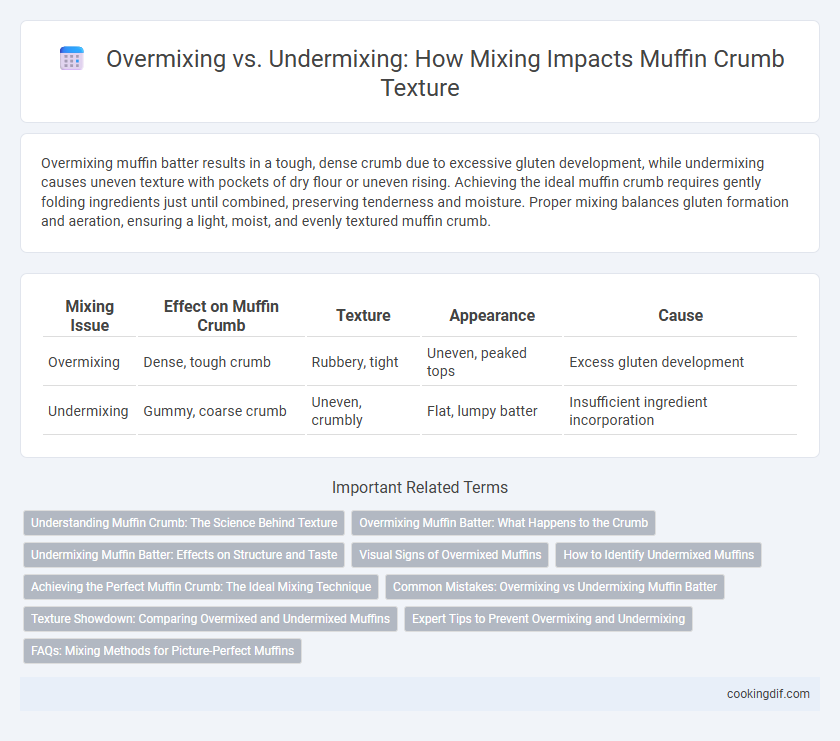Overmixing muffin batter results in a tough, dense crumb due to excessive gluten development, while undermixing causes uneven texture with pockets of dry flour or uneven rising. Achieving the ideal muffin crumb requires gently folding ingredients just until combined, preserving tenderness and moisture. Proper mixing balances gluten formation and aeration, ensuring a light, moist, and evenly textured muffin crumb.
Table of Comparison
| Mixing Issue | Effect on Muffin Crumb | Texture | Appearance | Cause |
|---|---|---|---|---|
| Overmixing | Dense, tough crumb | Rubbery, tight | Uneven, peaked tops | Excess gluten development |
| Undermixing | Gummy, coarse crumb | Uneven, crumbly | Flat, lumpy batter | Insufficient ingredient incorporation |
Understanding Muffin Crumb: The Science Behind Texture
Muffin crumb texture depends on the balance between overmixing and undermixing the batter, as overmixing causes excessive gluten development leading to a tough, dense crumb, while undermixing results in uneven distribution of ingredients and a coarse, crumbly texture. The ideal muffin crumb is achieved through gentle mixing, allowing for sufficient gluten formation to provide structure without compromising softness or creating tunnels. Controlling mixing time and technique directly influences crumb uniformity, moisture retention, and the overall mouthfeel of baked muffins.
Overmixing Muffin Batter: What Happens to the Crumb
Overmixing muffin batter causes excessive gluten development, resulting in a dense, tough crumb rather than a light and tender texture. This leads to peaked tops, tunnels, and a chewy interior that lacks the desired moistness of a properly mixed muffin. Controlling mixing time is crucial to prevent these undesirable textural changes and achieve a soft, evenly crumbed muffin.
Undermixing Muffin Batter: Effects on Structure and Taste
Undermixing muffin batter often results in a coarse, uneven crumb structure due to insufficient gluten development and incomplete ingredient incorporation. This leads to dense, heavy muffins with pockets of flour or baking powder, affecting both texture and rise. The flavor may also be inconsistent, as sugar and fat are not thoroughly distributed throughout the batter.
Visual Signs of Overmixed Muffins
Overmixed muffins develop a dense, tough crumb with large tunnels and peaked, cracked tops due to excessive gluten formation. The batter loses its lightness, resulting in a tight, compact texture rather than a tender, moist crumb. Visually, overmixed muffins often exhibit a shiny, rubbery surface and lack the desirable domed appearance seen in properly mixed batters.
How to Identify Undermixed Muffins
Undermixed muffins often have uneven crumb structure with large, visible pockets of flour or unincorporated ingredients, resulting in dense, gummy texture. The batter may separate before baking, causing muffins to rise unevenly or collapse. Identifying undermixed muffins involves checking for pale, wet spots inside and a heavier-than-normal mouthfeel, indicating insufficient gluten development and poor ingredient distribution.
Achieving the Perfect Muffin Crumb: The Ideal Mixing Technique
Achieving the perfect muffin crumb depends on avoiding both overmixing and undermixing the batter; overmixing develops excess gluten, resulting in a dense, tough texture, while undermixing leaves pockets of dry flour that cause uneven crumb structure. The ideal mixing technique involves gently folding the wet and dry ingredients just until combined, preserving tenderness and creating a moist, tender crumb. Monitoring mixing time closely ensures a balance between aeration and gluten formation, essential for that classic, soft muffin consistency.
Common Mistakes: Overmixing vs Undermixing Muffin Batter
Overmixing muffin batter develops excess gluten, resulting in a tough, dense crumb instead of a light, tender texture. Undermixing leaves pockets of dry flour and uneven distribution of ingredients, causing a crumbly or coarse consistency. Achieving the ideal muffin crumb requires gently folding the wet and dry ingredients until just combined, avoiding both overmixing and undermixing mistakes.
Texture Showdown: Comparing Overmixed and Undermixed Muffins
Overmixed muffins develop a dense, tough crumb due to excessive gluten formation, resulting in a chewy rather than tender texture. Undermixed muffins often have a coarse, uneven crumb with pockets of dry flour, leading to a crumbly and inconsistent mouthfeel. Achieving the ideal muffin texture requires a balanced mixing approach that ensures even ingredient incorporation without overdeveloping gluten strands.
Expert Tips to Prevent Overmixing and Undermixing
Expert tips to prevent overmixing and undermixing muffins emphasize gentle folding to achieve a tender, evenly textured crumb. Incorporate wet and dry ingredients until just combined, avoiding vigorous stirring that leads to tough, dense muffins or undermixing which causes uneven pockets of flour. Using a rubber spatula for folding and stopping as soon as no streaks of flour remain maintains the ideal crumb structure favored by professional bakers.
FAQs: Mixing Methods for Picture-Perfect Muffins
Overmixing muffin batter leads to dense, tough crumb due to excessive gluten development, while undermixing results in uneven texture with dry pockets and large air bubbles. Optimal mixing gently combines wet and dry ingredients until just incorporated, preserving tenderness and uniform crumb structure. For picture-perfect muffins, folding the batter carefully and stopping when streaks disappear ensures light, moist, and visually appealing results.
Overmixing vs Undermixing for muffin crumb Infographic

 cookingdif.com
cookingdif.com